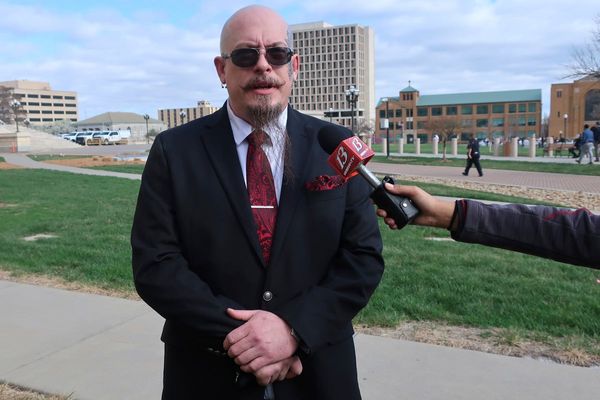WASHINGTON — Native Americans on reservations face another decade of underfunding from federal programs because thousands were not counted in the 2020 census — a problem shared by minority communities across the country.
Tribal governments use those federal funds for basic needs on reservations, where poverty rates historically have been among the highest in the nation. The federal government distributes $1.5 trillion annually based on census results, which missed 5 percent of Native Americans this time.
That will mean less money for food programs, building roads and keeping schools operational, said Joshua Arce, president of Partnership with Native Americans, a nonprofit providing education, infrastructure and other grants to tribes across the country.
“The programs these communities are eligible for, they’re really just for survival,” Arce said.
The Navajo Nation, mainly in northeastern Arizona, received a $3.4 million grant in 2021 to build water infrastructure like septic systems, for example. And the Pyramid Lake Paiute Tribe in northwestern Nevada plans to use a $1 million housing grant this year to build housing for elderly tribal members, a community laundromat, and handicap ramps for elders disabled by COVID-19.
Native Americans consistently have been the worst counted demographic group. But the 2020 census also missed a significant portion of other minority communities nationwide, according to a U.S. Census Bureau report released last month.
While the overall count was within 0.25 percent of the country’s estimated 331 million people, the agency missed almost 5 percent of the Hispanic population, the largest miss for that group in decades, and about 3 percent of the Black population, that report found.
Congress seeks solution
Advocates for minority communities and Democrats in Congress have pushed for the agency to address the undercounts before that data starts trickling into federal funding formulas.
While most federal programs do not directly use decennial census data for funding decisions, they do rely on dozens of different data sets the Census Bureau or other agencies create using the decennial count as a baseline.
A letter signed by 45 House members and led by Reps. Linda T. Sánchez, D-Calif., and Ruben Gallego, D-Ariz., asked the agency to provide more information about the undercounts and how it intends to keep them from impacting the distribution of federal funds.
“This misallocation would have a devastating impact on thousands of underserved communities across our nation, preventing resources from going to the programs and areas which need them the most,” the letter said.
In another letter, Sen. Bob Menendez, D-N.J., and 20 other Senate Democrats argued for the agency to “consider ways to correct the undercount in the annual population estimates derived from the 2020 census.”
A Census Bureau spokesperson said the agency had received the letters and was working on a response.
The agency also plans to release more information about the undercounts next month. That includes state-by-state undercounts, which advocates said will be key to assessing the census’ accuracy.
Finding a fix
The Census Bureau is contemplating how to address the undercounts in data used by federal agencies, and for now has a few existing tools to address local undercounts.
But those tools require a concerted effort from local communities that may already be strapped for resources. Arce pointed out that last decade the census missed a similar number of Native Americans, leaving them with fewer resources to build their communities up in the meantime or prepare for major events like the coronavirus pandemic.
The coronavirus pandemic hit Native American communities especially hard, Arce said, and the rural nature of reservations made it harder for the Census Bureau to count them in the middle of it.
According to the Centers for Disease Control and Prevention, Native Americans are more than three times more likely to get COVID-19 than white Americans, more likely to be hospitalized and more likely to die. According to the CDC, Native Americans had the highest mortality rate nationwide, with more than 440 deaths for every 100,000 people.
“Would that have been different if there was additional funding available 10 years ago? Would there have been more people saved if there was a greater push towards telemedicine?” Arce said. “I mean, those services, we’re talking about communities that lack basic needs, where they lack water, electricity, internet lines.”
Groups like the National Congress of American Indians have pushed for the Census Bureau to engage with Native American communities on the undercount.
“Every undercounted household and individual in our communities means lost funding and resources that are desperately needed to address the significant disparities we face,” NCAI president Fawn Sharp said in a statement after the undercount results were released.
The agency has held one tribal consultation addressing the undercount so far and will likely hear more concerns at an advisory committee meeting next month with representatives from minority groups across the country.
Counting problems
Census Bureau officials said the count faced “unprecedented” challenges amid the coronavirus pandemic and record wildfire and hurricane seasons that contributed to the misses.
Because many reservation residents lack internet access or mail service, census staff have to hand-deliver forms – a process that was delayed for months.
Several tribal governments also made the decision to close off their reservations in an effort to quarantine against the virus, which also meant delays to the count.
Advocates have also laid the blame on Trump administration decisions like ending the count early and a failed attempt to add a citizenship question to the form.
Census Bureau Director Robert Santos, who took the over the agency in January, said in an interview that many members of minority communities do not trust the government, making them reluctant to participate in the census.
“Having said that, at the end of the day, we were in a pandemic. It was unprecedented,” Santos said.
Arce though, said he feels the onus should be on the federal government to address the problems it created.
“Clearly it’s a broken system,” Arce said.







